Why this resume works
- Quantifies accomplishments: Measurable accomplishments, such as reducing project costs by 15%, showcase the applicant’s tangible impact and value.
- Showcases career progression: Starting as a junior structural analyst and advancing to structural engineer highlights the applicant’s career growth through increasing responsibilities over time.
- Uses action-oriented language: Using action verbs like “designed,” “supervised,” and “conducted” effectively conveys initiative and effectiveness.
More Structural Engineer Resume Examples
See more structural engineer resume examples to learn how to highlight your design skills, project management experience, and knowledge of building codes. These civil engineering resume samples will guide you in crafting a resume that stands out in the industry.
Entry-Level Structural Engineer
Why this resume works
- Centers on academic background: Focusing on a strong academic foundation, the applicant’s education section lists advanced degrees that reflect a commitment to excellence in structural engineering from top-tier institutions.
- Effective use of keywords: Incorporating industry-specific keywords like “structural analysis” and “project management,” the applicant optimizes their resume for applicant tracking systems (ATS).
- Shows digital literacy: The applicant showcases digital readiness by leveraging tools like AutoCAD and Revit, highlighting impressive computer skills essential for modern engineering projects.
Mid-Level Structural Engineer
Why this resume works
- Points to measurable outcomes: The applicant’s track record of reducing costs by 15% and saving $200K annually highlights their ability to achieve measurable outcomes with efficiency-focused strategies.
- Demonstrates language abilities: Language skills in Spanish offer the applicant an edge in cross-cultural communication, indicating their ability for global collaboration.
- Displays technical expertise: Expertise in AutoCAD and structural analysis, alongside certifications such as PE, showcases the applicant’s technical prowess necessary for complex engineering projects.
Experienced Structural Engineer
Why this resume works
- Showcases impressive accomplishments: By showcasing achievements like reducing project costs by 15%, the applicant effectively illustrates senior-level impact.
- Emphasizes leadership skills: Managing multi-million dollar projects and boosting efficiency by 30% reveals the applicant’s strong leadership skills and initiative.
- Focuses on work history: Using a chronological resume format to present roles from structural engineer to project engineer highlights extensive career experience.
Structural Engineer Resume Template (Text Version)
Min Park
Crestwood, KY 40015
(555)555-5555
Min.Park@example.com
Professional Summary
Experienced structural engineer with 8 years of expertise in structural design, seismic evaluations, and material optimization. Proven ability to manage multimillion-dollar projects, reduce costs, and enhance building safety. Proficient in AutoCAD, FEM, and compliance with building codes.
Work History
Structural Engineer
Skyline Design Group – Crestwood, KY
January 2021 – June 2025
- Designed 30+ structural systems using advanced CAD tools
- Reduced project costs by 15% through material optimizations
- Conducted structural evaluations for 50+ multi-story buildings
Civil Engineer – Structural Focus
Pinnacle Engineering Solutions – Crestwood, KY
January 2017 – December 2020
- Supervised construction of 20+ commercial buildings
- Enhanced structural integrity by identifying issues in 5 projects
- Achieved 10% faster completion time by optimizing workflows
Junior Structural Analyst
Blue Ridge Consulting – Louisville, KY
January 2015 – December 2016
- Provided structural analysis support for 25+ design projects
- Improved load analysis accuracy by 25% using FEM software
- Prepared technical reports supporting senior engineers
Languages
- Spanish – Beginner (A1)
- German – Intermediate (B1)
- Mandarin Chinese – Beginner (A1)
Skills
- Structural design optimization
- Seismic-resistant engineering
- Finite element analysis (FEM)
- AutoCAD and Revit proficiency
- Construction project management
- Material property evaluation
- Building code compliance
- Structural failure assessment
Certifications
- Professional Engineer (PE) – National Society of Professional Engineers
- Certified Structural Designer – Structural Engineering Certification Board
Education
Master’s Degree Structural Engineering
University of Washington Seattle, Washington
June 2015
Bachelor’s Degree Civil Engineering
University of California, Berkeley Berkeley, California
June 2013
Related Resume Guides
Advice for Writing Your Structural Engineer Resume
Explore our advice on how to write a resume tailored for a structural engineer role and discover how to highlight your engineering skills, project experience, and problem-solving abilities. Browse tips that will help you stand out in the field by showcasing your impact on infrastructure projects and innovative design solutions.
Highlight relevant technical skills
For a structural engineer, technical skills are essential. Some common technical skills for a structural engineer include knowledge of AutoCAD and Revit for designing structures, understanding building codes and standards, and experience with project management software like MS Project.
Skills in finite element analysis and familiarity with materials science can also be helpful. If you’ve worked with any specific engineering tools or programs before, mentioning them can show you’re ready to start working without needing much training.
Create a dedicated skills section on your resume and weave these skills into the work experience part. This helps employers see right away that you have what they need. When listing your skills, think about what each job needs most. Tailor your resume so it fits the role you want.
Use clear language that shows you know how to apply these skills in real-world situations. This way, you’ll make sure your resume gets noticed by hiring managers looking for someone just like you.
Example of a technical skills section
- Structural analysis software (SAP2000, ETABS, STAAD.Pro)
- Building information modeling (BIM) with Revit
- Finite element analysis (FEA)
- Reinforced concrete design
- Steel structure detailing
- Geotechnical engineering principles
- Project management tools (Primavera P6, MS Project)
- AutoCAD for drafting and design
- Construction safety standards and codes
- Sustainable building practices
You can use our Resume Builder to easily craft a standout resume that highlights your job-relevant skills and qualifications.
Quantify your accomplishments
Quantifying accomplishments on a resume makes it more compelling by showing exactly what you achieved in each role. Instead of just listing duties, you can highlight how your work made a difference.
For example, as a structural engineer, instead of saying “managed construction projects,” you could say “managed construction projects that reduced costs by 15%.” This shows the hiring manager not only what you did but how well you did it.
In the work experience section, it’s important to include your job title, employer name, location, and employment dates. This gives context to your achievements. To turn duties into achievements, think about measurable outcomes like percentages, time savings, cost reductions, or efficiency improvements. Use strong action verbs to describe these results.
For instance, “designed structural solutions that improved project efficiency by 20%.” By doing this, you’re creating a results-driven resume that helps hiring managers quickly see your impact and skills.
Quantified accomplishments make it clear what value you brought to previous employers and show potential employers what you could bring to their team. This approach makes your resume stand out in a competitive job market.
5 structural engineer work history bullet points
- Led the design and analysis of steel structures for a commercial project, resulting in a 20% reduction in material costs.
- Managed seismic retrofitting for a series of residential buildings, improving safety compliance by 30%.
- Collaborated with architects and contractors on a bridge construction project, decreasing project delays by 15%.
- Used finite element analysis software to optimize building designs, improving load capacity by 25%.
- Supervised junior engineers in developing structural plans for urban infrastructure projects, achieving a 95% approval rate from city planners.
Exploring professional resume examples can give you great ideas and help you see what works best for your job search.
Write a powerful professional summary
A professional summary on a resume serves as an introduction to hiring managers, giving them a quick overview of your career highlights.
When crafting your resume, you can choose between writing a summary or a resume objective. The choice depends on whether you want to focus on your past achievements or future goals.
A professional summary is a brief paragraph that highlights your experience, skills, and accomplishments. It’s ideal for experienced applicants like structural engineers who want to convey their professional identity and accomplishments in the field.
Conversely, a resume objective focuses more on stating career ambitions. It’s a good choice for those starting, such as entry-level engineers, individuals changing careers, or people with gaps in their work history. Here, the emphasis is on “what I aim to contribute.”
Next, we’ll share examples of both professional summaries and objectives tailored for various industries and experience levels so you can see the differences and decide what’s best for you.
Structural engineer resume summary examples
Entry-level
Recent structural engineering graduate with a Bachelor of Science in civil engineering from an ABET-accredited program. Completed internships focusing on foundational design and analysis, including coursework in finite element analysis and materials science. Eager to apply technical knowledge and CAD skills in entry-level structural engineering roles while pursuing EIT certification.
Mid-career
Structural engineer with over seven years of experience specializing in commercial building design and residential projects. Proven track record in managing project timelines, performing detailed structural analyses, and coordinating with cross-functional teams. Licensed Professional Engineer (PE) known for delivering cost-effective solutions while ensuring compliance with safety standards and regulations.
Experienced
Senior structural engineer with 15+ years of expertise in high-rise building projects and seismic retrofitting. Extensive leadership experience guiding engineering teams through complex challenges to the successful completion of multi-million dollar projects. Recognized for innovative use of technology to improve design efficiency and reduce project costs, while maintaining a commitment to sustainability and safety.
Structural engineer resume objective examples
Entry-level
Energetic and detail-oriented structural engineering graduate seeking an entry-level position to apply academic knowledge in structural analysis and design. Eager to contribute to a collaborative engineering team by assisting in the development of safe and sustainable infrastructure projects.
Career changer
Dedicated professional transitioning into structural engineering from a background in construction management, with strong project coordination skills and a keen interest in building design. Aspires to leverage practical experience and technical training to support innovative engineering solutions.
Recent graduate
Recent civil engineering graduate with a focus on structural systems, seeking an opportunity to work as a junior structural engineer. Committed to applying theoretical insights and software skills in AutoCAD and Revit towards designing efficient structures that meet safety standards.
Pick a straightforward resume template that features clear section headings and simple fonts. Steer clear of excessive colors or elaborate designs, helping employers quickly read your skills, jobs, and education.
Showcase your credentials
Listing certifications, licenses, and specialized training is essential for structural engineers because it shows you meet industry standards and have the skills needed for complex projects. These credentials demonstrate your knowledge in areas like safety regulations, materials science, or advanced design software.
Including a dedicated certifications section ensures that hiring managers can quickly see your qualifications without having to search through other parts of your resume. Here are a few examples of certifications to include on your resume:
- Professional Engineer (PE) License
- Structural Engineering Certification Board (SECB) Certification
- Certified Welding Inspector (CWI)
- AutoCAD Professional Certification
- LEED Accredited Professional
Structural engineering often requires adherence to strict codes and standards, so these credentials play a role in building trust with employers. Ensure your certifications are current and listed prominently to strengthen your application.
Example of a certifications section
Certified Structural Engineer (SE)
Issued by: Structural Engineering Certification Board (SECB)
Issued 2022
Professional Engineer License
Issued by: National Council of Examiners for Engineering and Surveying (NCEES)
Expires 2025
LEED Accredited Professional
Issued by: Green Business Certification Inc. (GBCI)
Issued 2021
AutoCAD Civil 3D Certified Professional
Issued by: Autodesk
Expires 2024
OSHA Safety Certificate
Issued by: Occupational Safety and Health Administration (OSHA)
Issued 2023
Use a polished and professional resume format that aligns with your experience level to ensure your skills and qualifications stand out to hiring managers.
FAQ
Do I need to include a cover letter with my structural engineer resume?
Yes, including a cover letter with your structural engineer resume can set you apart from other applicants in the hiring process. A cover letter allows you to tailor your application by showing specific interest in the company and explaining how your experience matches their projects or values.
For example, if a firm focuses on sustainable building design or innovative infrastructure solutions, you can highlight your relevant expertise or passion for these fields.
Consider using tools like our Cover Letter Generator to create a personalized letter based on your resume details, offering step-by-step guidance to boost content quality.
Additionally, checking out industry-specific cover letter examples can provide inspiration and insight into effective writing techniques tailored to structural engineering roles.
How long should a structural engineer’s resume be?
For a structural engineer, a one-page resume is typically enough if you have less than 10 years of experience. This format keeps your information focused and relevant, highlighting key skills like design software, project management, and structural analysis.
If you have extensive experience or specialized certifications, a two-page resume can be suitable. Ensure every detail is relevant to your career stage, showcasing significant projects, technical expertise, and leadership roles.
To find the right length for your situation and career stage, check out our guide on how long a resume should be for examples and tips.
How do you write a structural engineer resume with no experience?
If you have no experience, center your structural engineer resume on education, skills, and relevant projects that show your potential in the field. Here are a few tips on how to write a resume with no experience:
- Highlight your education: Begin with your degree in civil or structural engineering, mentioning the institution, graduation date, and any honors received. Include coursework related to structural analysis or design.
- Showcase projects and internships: Even if they were part of your academic program, list any projects where you applied engineering principles. Describe your role and the impact of the project on developing structures or systems.
- Emphasize technical skills: Detail your skills with software such as AutoCAD, Revit, or SAP2000 that is essential for structural engineering tasks. Mention any skills gained through workshops or online courses.
- Include certifications: If you’ve completed certifications like Engineer-In-Training (EIT) or participated in professional seminars, include them to show commitment to the profession.
Focus on presenting your education, skills, and project work in a clear, confident way to demonstrate your readiness for a structural engineering role.
Rate this article
Structural Engineer
Additional Resources
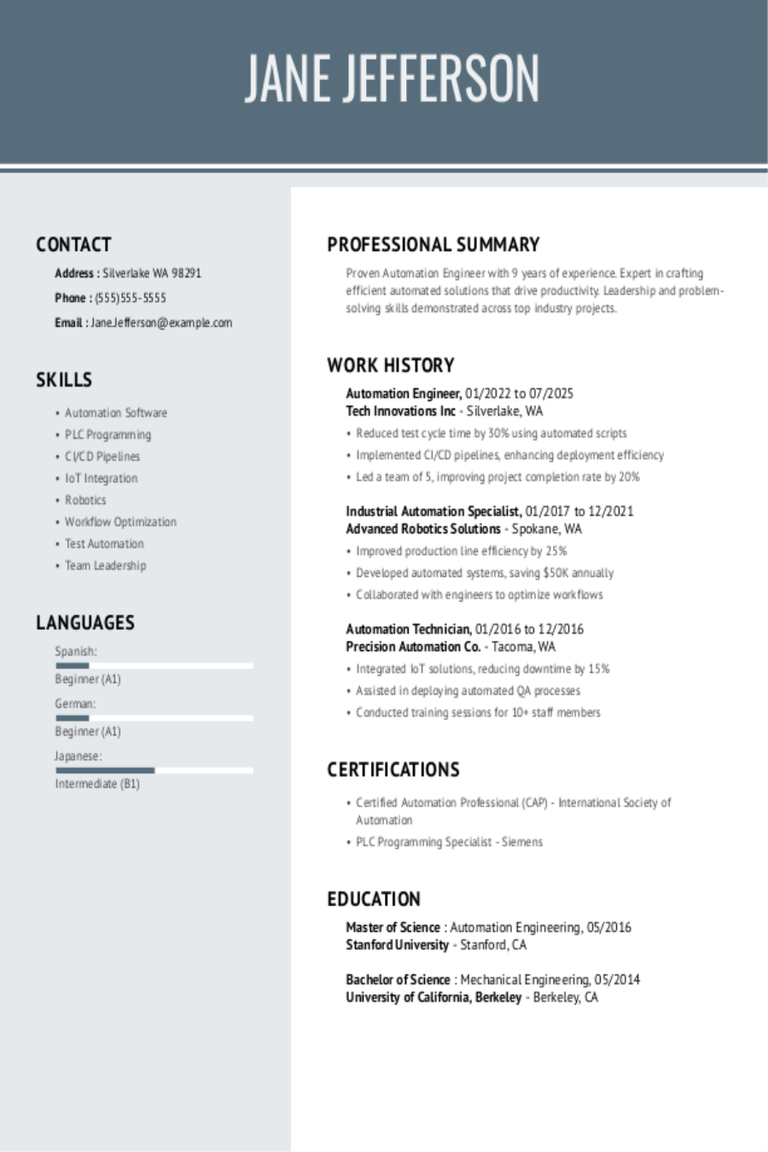
Automation Engineer Resume Examples & Templates for 2025
Automation engineers play a vital part in modern industries and businesses. They aim to enhance efficiency by designing, developing and implementing systems that automate different tasks and processes. Explore our guide
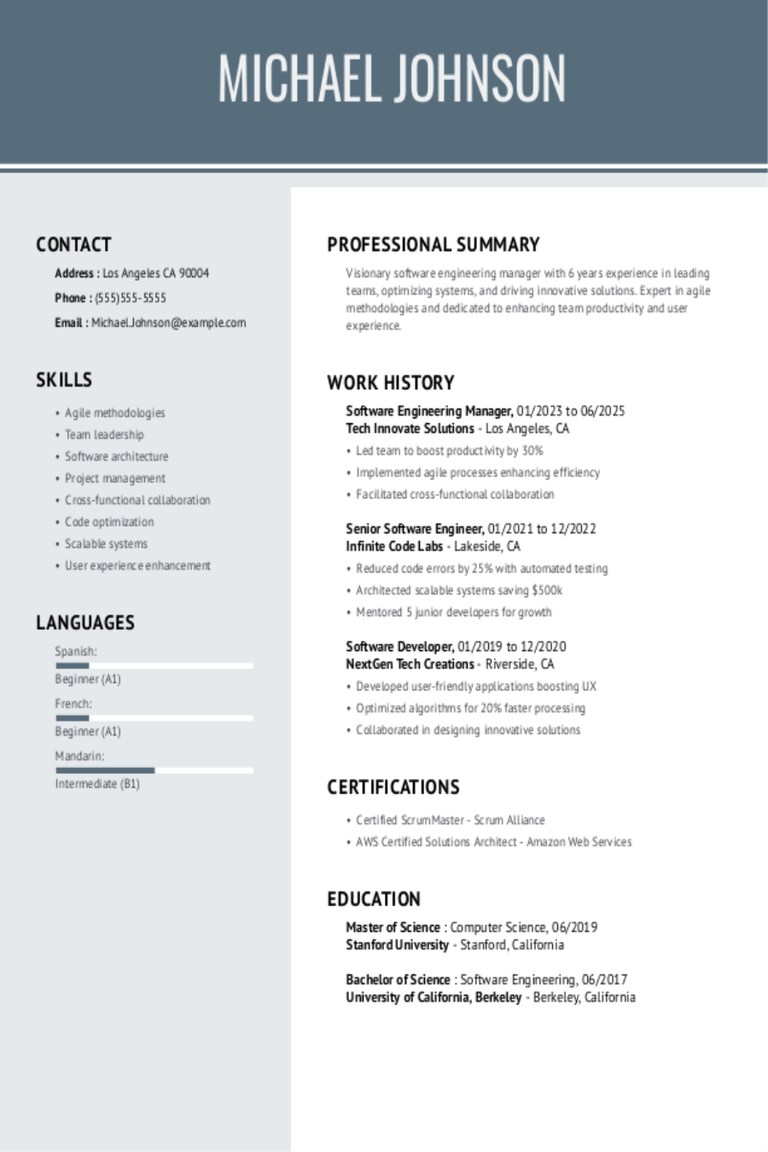
Software Engineering Manager Resume Examples & Templates for 2025
A great job as a software engineering manager demands a perfect software engineering manager resume and we are here to help you create one. Our guide to crafting a perfect
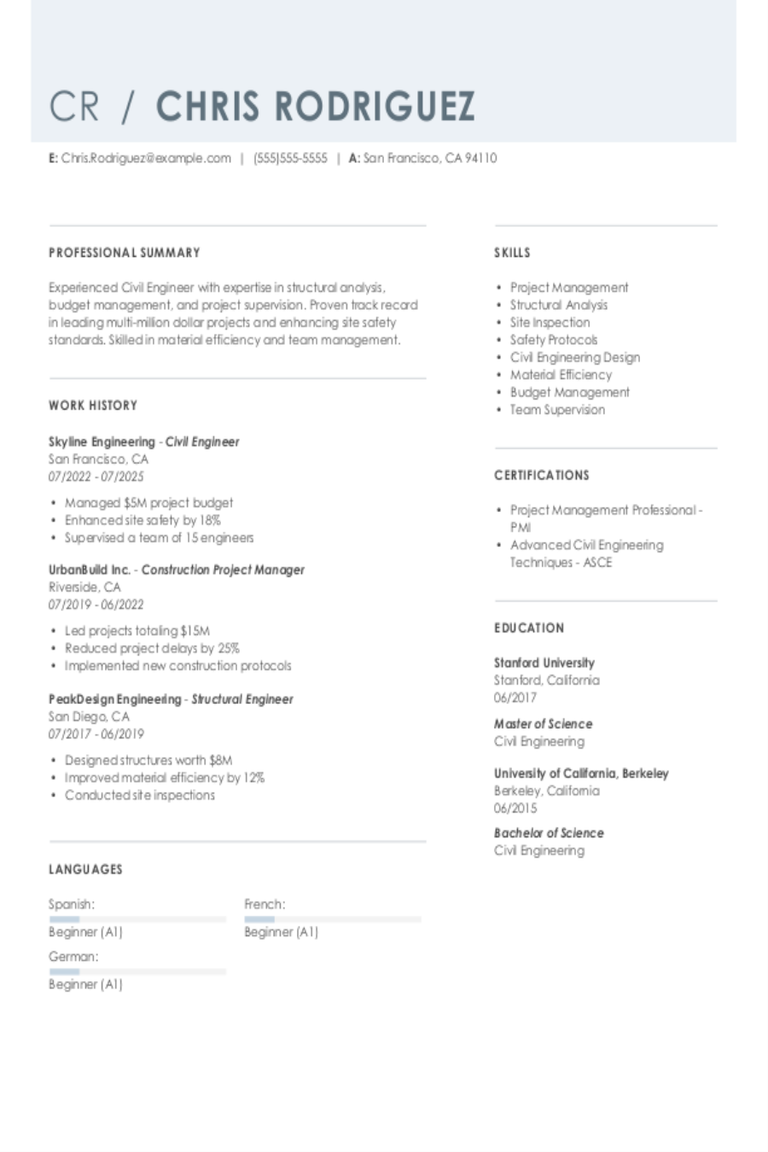
Civil Engineer Resume Examples & Templates for 2025
Entry-level
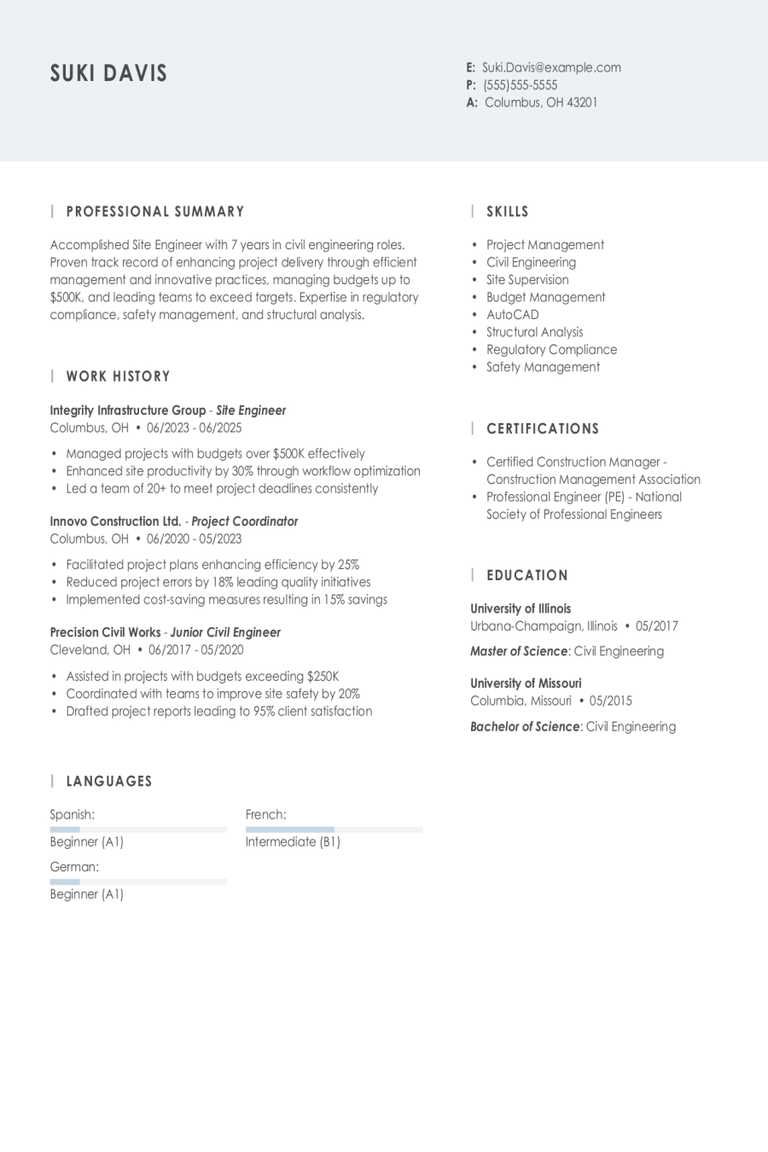
Site Engineer Resume Examples & Templates for 2025
Seeking a job as a site engineer? A well-written Resume is a great place to start, and we’re here to help! This guide to writing an effective site engineer Resume
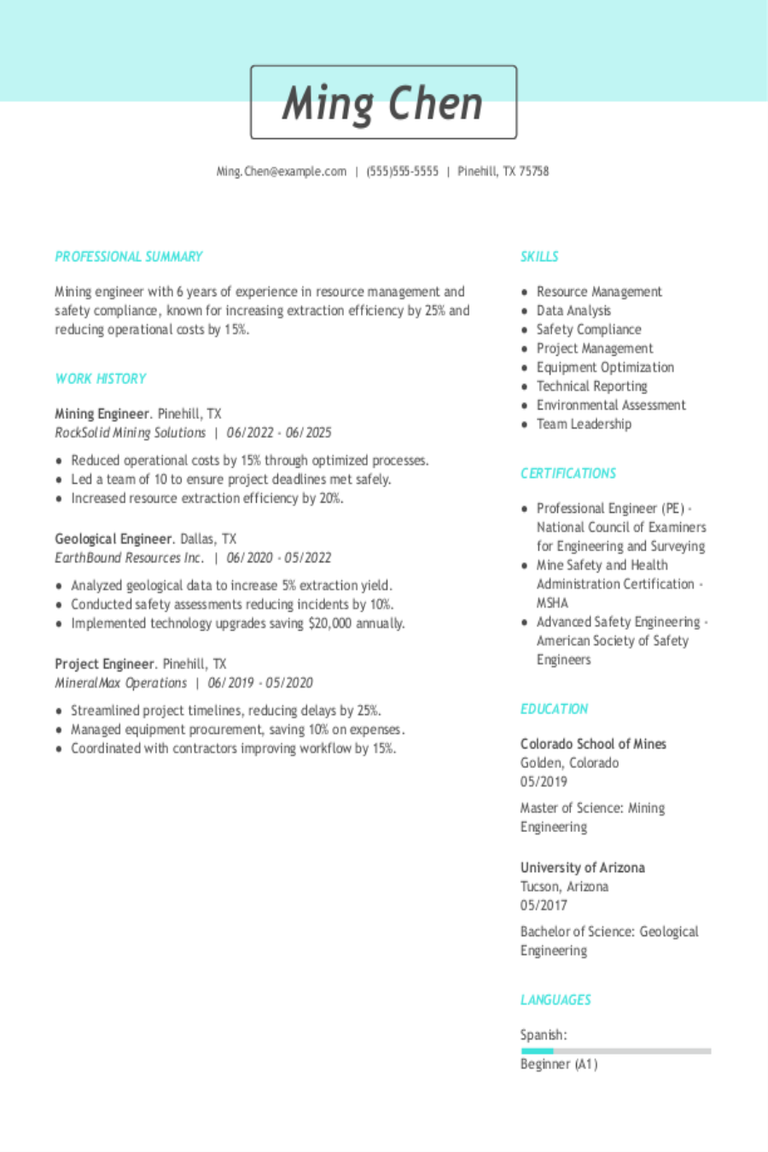
Mining Engineer Resume Examples & Templates for 2025
A great job as a mining engineer demands a perfect mining engineer resume. Not sure what that looks like? Don’t worry! We’re here to help you create one. Our guide
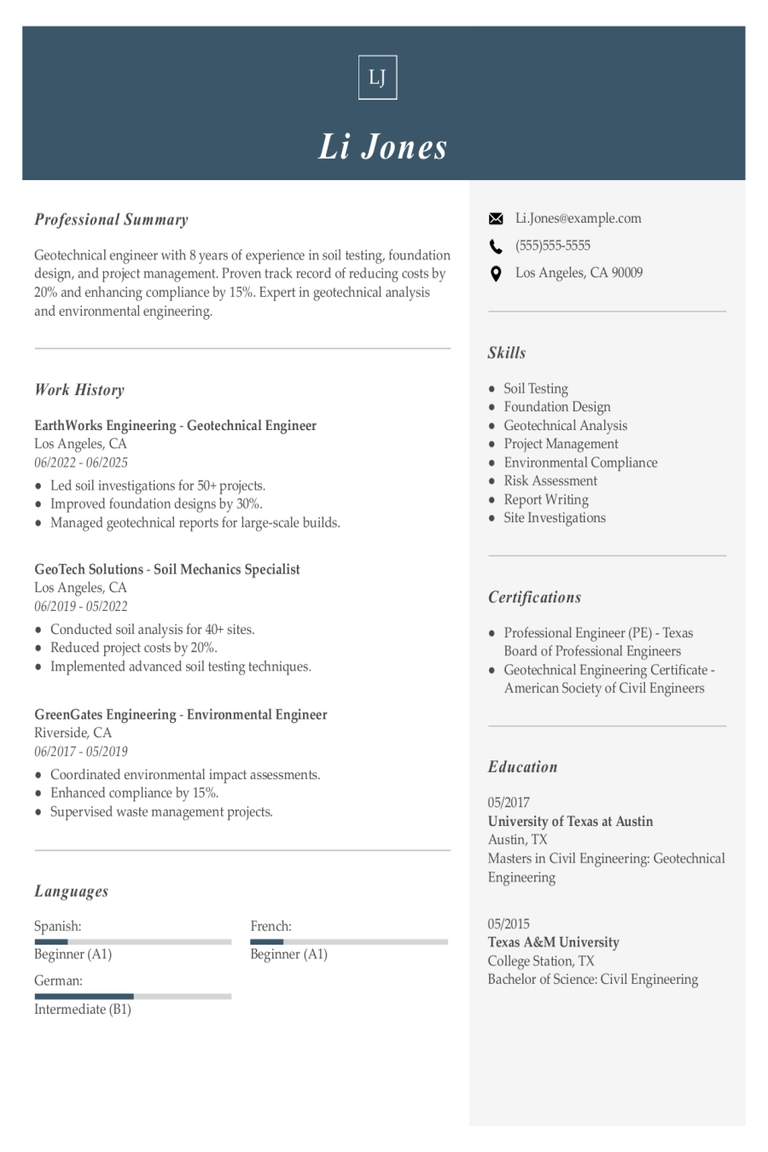
Geotechnical Engineer Resume Examples & Templates for 2025
A geotechnical engineer investigates and analyzes sites to evaluate their suitability for a construction project. They use advanced scientific and mathematical engineering principles to figure out the impact of geological
